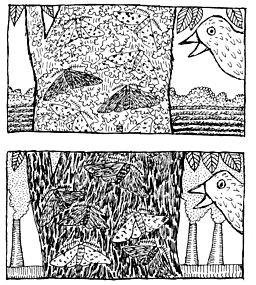In Part 1 of this post, I introduced my new series, Misconception Monday, and let you in on the secret to my misconception know-how: student test papers. In this conclusion, I want to get into some ways that this misconception—that natural selection eliminates all bad variations—could be tackled, or even headed-off, in the classroom.
Here are a few of the routes you can take:
 1) Follow the well-trod path. Use your old friends the peppered moths. The basic outline of this example is well-known, but with some well-chosen emphasis points, it can be used to demonstrate the mis of this misconception. Until the industrial revolution in England, light-colored moths were far more common in England than dark-colored moths. By the early 19th century however, the dark-colored form came to predominate. In one highly polluted city in 1895, 98% of moths were reportedly dark—98%, not 100%. Indeed, if the light-colored form had completely disappeared, we would not have observed the shift back toward the light-colored forms that predominate populations in today’s far less sooty England. Even now, variation within the species results in a scattering of dark-colored individuals. (Don’t be misled by creationist propaganda about the example not surviving analysis. As the previous link explains, Michael Majerus, the late expert on the peppered moths, has shown that it remains an excellent example. Here are links to a paper and a book he wrote on the topic.)
1) Follow the well-trod path. Use your old friends the peppered moths. The basic outline of this example is well-known, but with some well-chosen emphasis points, it can be used to demonstrate the mis of this misconception. Until the industrial revolution in England, light-colored moths were far more common in England than dark-colored moths. By the early 19th century however, the dark-colored form came to predominate. In one highly polluted city in 1895, 98% of moths were reportedly dark—98%, not 100%. Indeed, if the light-colored form had completely disappeared, we would not have observed the shift back toward the light-colored forms that predominate populations in today’s far less sooty England. Even now, variation within the species results in a scattering of dark-colored individuals. (Don’t be misled by creationist propaganda about the example not surviving analysis. As the previous link explains, Michael Majerus, the late expert on the peppered moths, has shown that it remains an excellent example. Here are links to a paper and a book he wrote on the topic.)
2) Invoke our fascination with disease. The human disease sickle-cell anemia and the equine disease of lethal white overo are both great examples of how a deleterious or even lethal recessive allele can be maintained in population—the former by natural selection and the latter by artificial selection. In both cases, individuals that carry the disease allele have an advantage over individuals that do not. Natural selection therefore favors individuals that carry the allele, increasing the number of disease alleles present in the population. Any time two carriers mate, their offspring have a 25% chance of having the disease—so the disease not only persists, but it is present in higher-than-expected numbers.
Huntington disease is an example of a dominant lethal allele that is maintained because it does not usually affect an individual’s health until after reproductive age. Individuals with the disease have a 50% chance of passing it on to their offspring, but they may not know that they are affected until after they have children. No matter how disadvantageous a trait is, it cannot be influenced by natural selection until it is expressed.
3) Demonstrate how probability works. Smoking causes lung cancer, right? But not all smokers die from lung cancer; in fact, most don't. Similarly, a trait that is "harmful" does not uniformly result in a reduction in fitness for those individuals possessing it. If you have the time, a simple classroom activity can help to get this important point across. Scatter a few hundred beans of different colors on a lawn and give your students 20 seconds to pick up as many as they can and put them in the cup. Some of the beans will be better camouflaged than others, so you should see some differential bean “fitness”—but they won’t be able to find all of even the most brightly colored beans if given limited time. Natural selection works the same way.
Trust me when I say that this misconception is out there in force. So many times I wanted to reach into the test papers I was reading to ask the student follow-up questions, to help them understand. But I couldn’t, I wasn’t (and am not) a teacher—but I bet some of you are! So please, let me live vicariously. And if you’re in Massachusetts, help out my friends who will be reading your students’ test papers one day.

